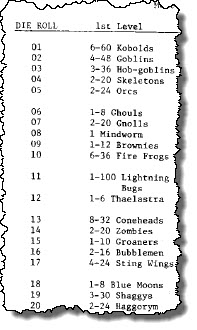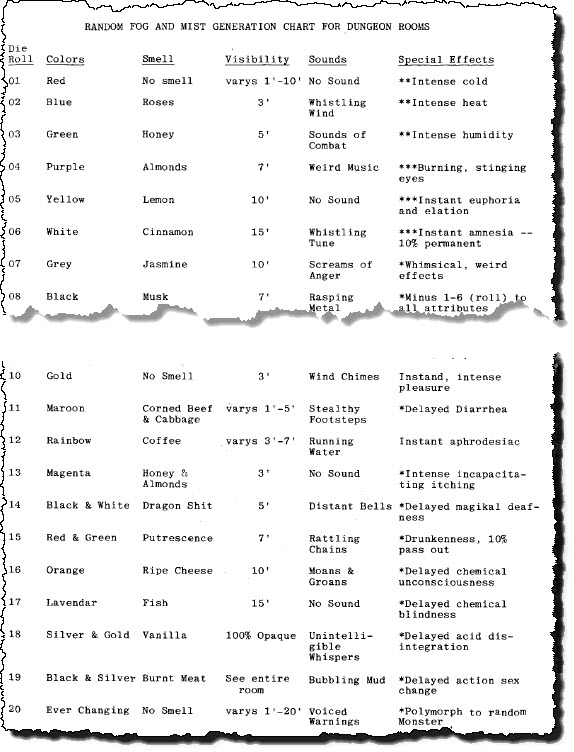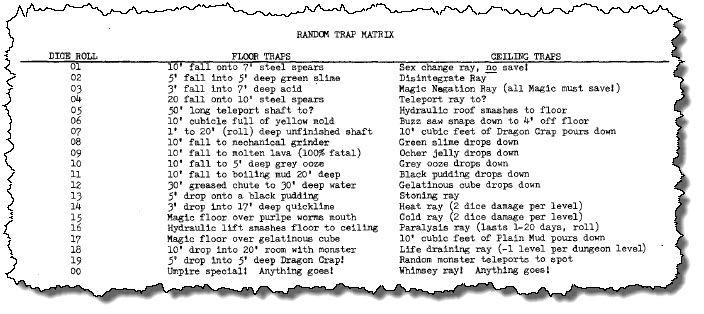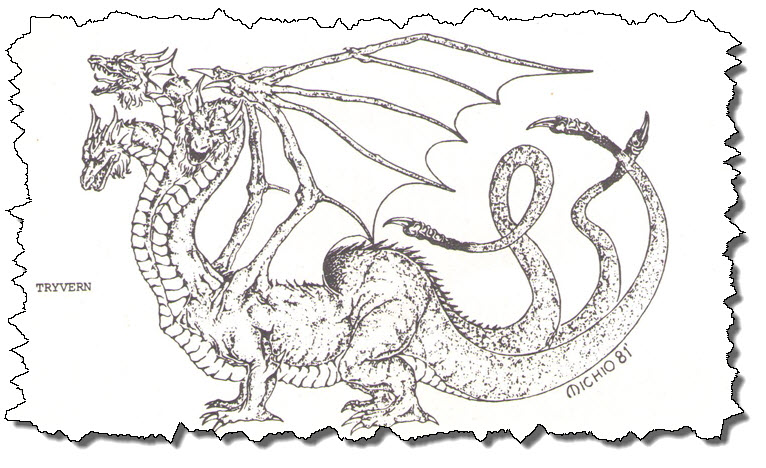Arduin Grimoire, Part XIV
Arduin Grimoire, Part XIV
Mists and Maladies
And Traps
(And Coneheads)
OK, another short one… this time, my excuse is having to remote in to work to make up for time I missed, since I’m a contractor and have to bill by the hour. But I am determined to be regular about my posting… as I age, regularity becomes very important. Ask Wilford Brimley. (“Who?” ask all the kids in the audience.) The encounter tables are pretty much what you’d expect — roll some dice and see what shows up to kill the players. Even so, this being Arduin, there are some hidden gems (1% chance of spotting, guarded by a poison trap with a -4 save, of course).
Please note a few things: First, you could easily encounter huge numbers of creatures in a single go. This may have been due to the original “number appearing” in “Monsters & Treasures”, but those figures were based on outdoor encounters in the “hex crawl” mode, where you might stumble on an encampment of 300 orcs. Buried later in “The Underworld & Wilderness Adventure” are rules for determining the number of creatures encountered in a dungeon, and they are utterly incomprehensible. Here, let me show you:
I sometimes give Dave Hargrave grief for leaving out key elements or data, but nothing in Arduin approaches this level of inscrutability.
So, anyway, that’s why you could run into 36 hobgoblins or 32 coneheads…
Wait, what? Coneheads?
Given the date of publication, and the fact they’re not listed in the new monster section, I have to assume they are, in fact, referring to the Saturday Night Live creatures.

Yeah, These Guys
Hey, why not! (The lack of stats in the book is Yet Another Indicator that the Grimoire was literally pieced together from Dave’s personal notes and writings; he may have simply forgotten to remove that entry from the encounter table.)
Anyway, that’s that. We’ll be covering the monsters themselves, soon.
Before that, though — Mists!
Old School Gaming: Even The Air Wanted To Kill You
We now get to the “random fog and mist generation chart”, because of course when you kick down a door in a dungeon, each room might have its own atmosphere… evidently, all those kickable, rotted wooden doors formed airtight seals. Go figure.
Presumably, you rolled randomly on each column. There’s a footnote stating that this chart allows dungeon rooms to have weird and random effects “without annotating the map”. In short, this chart is there to let the DM screw with the players without the pretense of “wandering monsters”, and without any foreknowledge of what might happen. Just decide a room has a mist, and roll some dice… like this…
20: Ever-changing color
9: Sulfur smell.
4: Visibility, 7 feet, which works perfectly well with absolutely no mapping scale known to humanity. “The orc is in this hex, but you can’t see him.” “Why not?” “Well, the front of the hex is five feet away, but the back is ten feet away, and he’s staying towards the back.”
3: Sounds of combat.
13: Intense Incapacitating Itching. I see Dave, like myself, got regular paychecks from the American Alliteration Association.
But suppose simply flooding the room with random gasses wasn’t enough? (Insert your own “The DM shouldn’t have made chili for game night” joke here.) And suppose you failed to insert a trap in every single map square? Well, that’s OK. There’s a random trap chart, too.
Note:
- Most of these don’t have damage listed. Presumably, the exact effects of falling into a mechanical grinder or being smashed against the ceiling are up to the tender mercies of the “Umpire”. (The term “DM” was still one of many floating around; “Umpire”, “Referee”, “Judge”, or “You Bastard” were also common.)
- The notes (not shown) indicate a 10% chance per level of spears being poisoned.
- They also note that “monster rooms” have level-appropriate monsters, and that occupied spider webs are particularly fun.
- Please note that a fall into molten lava is always fatal, even if, and I’m talking to you, Bob, you’re wearing +1 leather. (Relevant portion begins 40 seconds in.)
- Random Gender Changing was, like, a thing back then. Naturally, when it occurred, it was used to explore issues of sexism, socially constrained gender roles, and intersectional feminist issues from a multicultural perspective that recognized alternative ways of knowing and encouraged the removal of binary identity concepts.
- Magic floors disappear 1-10 seconds after the first person has walked on them, so that many people can be trapped at once. Good luck figuring that out by pouring water on the floor and seeing how it pools.
And, alluding to alliteration…
Most Malignant & Malefic Miseries Known
Seriously, That’s What The Section Is Called
Why Would I Lie If Money Isn’t Involved?
(And Trust Me, It Isn’t)
So the air hasn’t killed you, nor has the hot oatmeal. What’s left?
Only everyone’s favorite horseman of the apocalypse, plague!
There’s no particular rules for catching these diseases, or curing them. They just do horrible things to you, until they don’t. A few selections:
- The Scarlet Screaming Sickness: No damage, but the pain is so bad there’s a 10% chance per day the victim will go insane, and it lasts 5-10 days.
- The Melting Sickness: You “melt” 10% per day, and it lasts 1-10 days, so if lasts 10 days, you’re dead. Otherwise, you just look molten — full wish to cure.
- Steaming Death: Body moisture boils off you in the form of steam, causing you to die, always, looking a withered apple in 10 hours.
- The Bursting Sickness: The victim continually burps and passes gas (ah, the maturity of the age…), until he explodes like “an overripe grape” in 4-6 hours, and dies.
- The Withering Wakefulness: The victim can’t sleep and ages 3 years per day. This lasts 3-30 days, and there’s a 7% chance per day past 10 of insanity from sleeplessness.
So, unless you’ve got a cleric with Cure Disease handy, you’re basically screwed.
Next time, monsters. In the meanwhile, here’s a tryvern.






Pingback:Arduin Grimoire, Part XV | Lizard's Gaming and Geekery Site